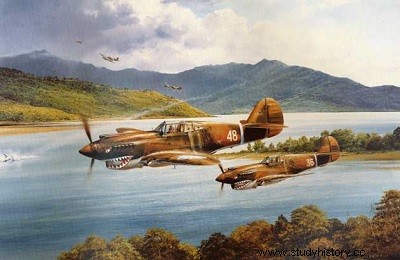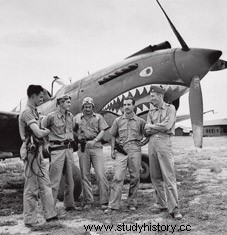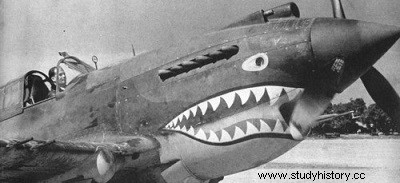
The Flying Tigers is the nickname given to a squadron of American pilots, officially known as the 1st American Volunteer Group, or AVG. Based in China during the Second World War, the squadron took part in the Sino-Japanese war and the Burma campaign. It was incorporated during the conflict into the United States Army Air Forces.
History
Claire Lee Chennault, Chiang Kai-shek's military adviser, sought from 1938 to form an air force intended to come to the aid of the Chinese government, a force inspired by the model of the American Army Air Corps. United States neutrality laws make the operation illegal, but it is approved by President Roosevelt himself. Thus, during the winter of 1940-1941, Chennault managed to import a hundred Curtiss P-40B aircraft into China. This had been done even before the approval of the Lend-Lease program by the American parliamentary chambers. Chennault also recruited 100 pilots and 200 technicians, the pilots counting 60 men from the United States Marine Corps or the United States Navy, and 40 from the United States Army Air Corps.

His men were paid by a private military company, Central Aircraft Manufacturing Company, the unit is technically composed of mercenaries, presented nevertheless under the name of Volunteers and benefiting from the approval of Franklin D. Roosevelt, unofficial support because no written executive order seems to have ever been signed.
Creation
Carrying civilian passports, the recruits arrive via Burma, where they disembark at Taungû. Until then, the Soviet Union had provided unofficial support for a squadron of fighter aircraft under the name of the Soviet Volunteer Group:the withdrawal of Soviet pilots, following the Soviet-Japanese non-aggression pact makes the support of Chennault's group all the more necessary. The American squadron received from 1941 the name of 1st American Volunteer Group, officially created by direct order of Chiang Kai-shek.
The squadron's nickname comes from the painting first done by Eric Shilling, one of the pilots, on the nose of his plane which depicts a gaping shark's mouth open. It is itself inspired by the paintings done on their Messerschmitt Bf 110 by the pilots of the Haifischgruppe ("Shark Group", in fact the II/ZG 76) of the Luftwaffe.

Pilots are trained from the summer of 1941, among them is a certain Gregory Boyington, a number not yet experienced enough. The first groups are based in Kunming, southern China, and tasked with protecting strategic supply points in Burma. Claire Lee Chennault sets up a new group of "American Volunteers", the 2nd American Volunteer Group, equipped with Lockheed Hudsons and Douglas DB-7s, and plans to create a third, but the attack on Pearl Harbor and the The official entry into the war of the United States renders this program obsolete. Although bearing the official name of the "First" group of American volunteers, the Flying Tigers are the only ones to have actually fought.
The first combat of the American Volunteer Group took place on December 20, 1941 and ended in victory, the Japanese air raid on Kunming being repelled. The Flying Tigers then took part in the Burma campaign, shooting down fifty Japanese aircraft as part of the defense of Rangoon.
Absorption into the United States Air Force
From the spring of 1942, the United States Army Air Forces began to officially take over. Resuming service in the American army, Chennault became the head of the China Air Task Force. On July 4, 1942, the American Volunteer Group was officially disbanded and replaced by the 23d Fighter Group of the China Task Force. Five pilots, five officers and 19 technicians from the AVG join the 23d Fighter Group, the rest being assigned to other military units, choosing to work in air transport in Asia, or return to civilian life
At the end of the war, former "Flying Tigers" will be recruited by the CAT (Civil Air Transport), founded in 1946 by Chennault. This airline, nicknamed the "Flying Tiger line", close to the CIA, distinguished itself in particular by assisting the French during the battle of Diên Biên Phu in 1954. It subsequently merged with Air America and remained linked to the CIA. ..
In tribute to the first group of the Flying Tigers, the 23d Fighter Group chooses to keep the emblems and the "shark mouth" of the AVG aircraft, being the only unit of the United States Air Force to be able to afford this distinction. The China Task Force was, in March 1943, replaced by the 14th USAAF, which also took up a variation of the emblem, and was given the nickname.
In 1992, shortly before the fiftieth anniversary of the end of the squadron, its members were all incorporated, retroactively, among the veterans of the American Air Force. In 1996, survivors were decorated with the Distinguished Flying Cross (for pilots) or the Bronze Star (for ground personnel)1.
Despite its short-lived existence (seven months), the Flying Tigers Squadron has had a lasting impact on the history of American military aviation, as evidenced by the references that are still made there today. The 14th USAAF still uses the tiger as its emblem, the 23d Fighter Group having retained the Flying Tigers inscription on its own.
The term Flying Tigers can therefore still be used today to designate, depending on the context, the 23d Fighter Group, or the 14th USAAF as a whole, although the nickname is, historically, that of the 1st American Volunteer Group.
